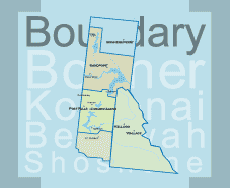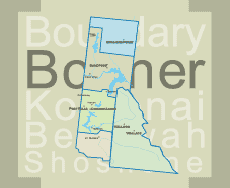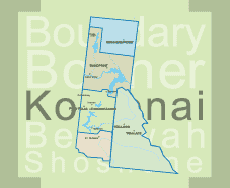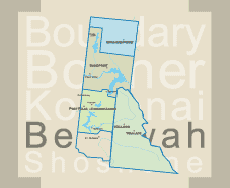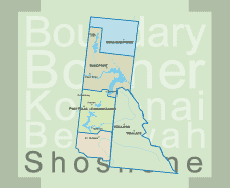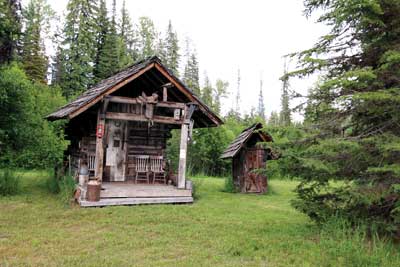is long and rich, filled with timber barons and mining magnates. The Cataldo Mission located in the Silver Valley is the oldest standing building in Idaho. The mission was built by Jesuit priests and the Coeur d'Alene Indian tribe and was completed in 1853. Ft. Sherman located at the mouth of the Spokane river in downtown Coeur d'Alene was established in the mid 1800's and is now the home of North Idaho College. The history of this region is held with pride and respect. North Idaho was developed by hard working, diverse people who recognized the importance of this region's resources, both human and natural.
The Cataldo Mission
The Old Mission (Mission of the Sacred Heart) is the oldest standing building in Idaho. Jesuits (Blackrobes) arrived at the invitation of the Coeur d'Alenes in the early 1840's. The first mission church was established on the St Joe River about 35 miles south of the present site. Due to flooding, it was closed in 1846, and a new mission church was begun on this site, which has always been sacred to the natives of the area.
The Old Mission (built 1848-1853) was a combined effort of the missionaries and over 300 native Catholics. Fr. Ravalli, an Italian born Jesuit, designed the building to resemble the elegant cathedrals of his homeland, using local materials. Wood was milled on the site, and wattle and daub construction used to make the walls both durable and light. The decorations of the interior illustrate both the piety of the workers and their ingenuity. Chandeliers were constructed from old tin cans, the altar was faux-painted to resemble marble, etc.
The Old Mission was the site of the council following the conflict with Col. Steptoe, and also served as headquarters for the Mullan Road crew.
In 1887, the mission itself was moved to DeSmet, Idaho, to the Coeur d'Alene reservation. The building still stands, as a monument to the cooperation of the Coeur d'Alene tribe and their missionaries. The mission sits on a beautiful knoll, overlooking the Coeur d'Alene River. The mission and parish house are open for tours, there are picnic grounds and walking paths with unobtrusive interpretive speeches, a Visitor's center with a film show, and two historical cemeteries.
Three events occur annually:
1) 2nd Sunday of July- Historic Skills Fair, where costumed participants demonstrate pioneer crafts, and fiddlers play
2) Aug 15- The Feast of the Assumption Pilgrimage by the Coeur d'Alene Indians
3) Third weekend in August- Annual Mountain Man Rendezvous.
Rathdrum County Jail
This jail was built in 1892 while Rathdrum was the county seat in Kootenai County. It was the first sturdy brick jail and built around 8 cells, stacked 4 on 4 and made of riveted steel since welding was not yet in use. It also had room on the second floor for a county hospital and a place for the insane on their way to Blackfoot.
In 1908 when the county seat was moved to Coeur d'Alene, the jail became the city hall and then the town library for many years. It was then used as a maintenance building, fell into disrepair and was given to the Historical Society. Don and Dorothy Jacklin saw the potential of the building and donated money to restore it in 2010. The Historical Society is working to fill the jail with displays as well as bring back the look and feel of the jail in several rooms.c
Pleasantview School Grand Opening 1910
On June 3, 1909, a school bond was passed for the construction of a new two-story brick and stucco school building in the Pleasantview District of Kootenai Co., Idaho. The plans for this building were a big step up from the one-room frame schoolhouse just down the road a half-mile to the west, which had been in use since the fall of 1904. Construction began during that summer of 1909 and the new school, complete with His-and-Hers privies out back, was dedicated on Thanksgiving Day, 1910.
Initially classes were held in two spacious 2nd floor classrooms (Grades 1 - 8 in the west room, Grades 9 - 12 in the east room). The auditorium, furnace room and teacher's quarters were on the 1st floor. Later, students in Grades 9 - 12 were sent to school in Post Falls and the west classroom became a recreation hall. By 1912 the massive furnace had been replaced with twin Smith System wood burners (one upstairs, one down), leaving the original furnace room space to be converted to a classroom for Grades 1 - 3. Grades 4 - 8 remained in the west classroom upstairs. The school operated until spring of 1937 and was officially consolidated with the Post Falls School District in 1940.
Pleasantview School remained a center for community activities: social clubs, charities, church services and 4H club for several decades after the 1937 closure; however, time and neglect took its toll on the building until 1971, when Glen Madison organized the Pleasantview Community Association and took steps to have the school registered with the Idaho Historic Preservation Council. The school district then quit-claimed the building and land to the Association, and in 1985, the building was placed on the National Historic Registry.
